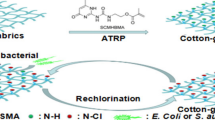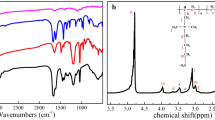Abstract
Antibacterial fabrics have attracted wide attention since bacterial infection remains a leading threat to global health due to the abuse of antibiotics and the emergence and spread of drug-resistant pathogens. A novel tert‐butoxycarbonyl (Boc) protected guanidine containing isocyanate group (NCO) (IGUA-Boc) was developed and covalently bonded onto the cotton fabric surface to fabricate excellent antibacterial cotton fabrics with negligible cytotoxicity via dipping-padding-drying process followed by deprotection of Boc group through the acidification process. The guanidine-functionalized cotton fabrics could well retain their mechanical properties, hydrophilicity, moisture permeability, air permeability, softness and whiteness. More importantly, the antibacterial rates of the guanidine-functionalized cotton fabrics against Gram-negative Escherichia coli and Gram-positive Staphylococcus aureus were up to 88.5% and 99.9%, respectively even after 50 laundering cycles, which were much larger than that finished with commercial antibacterial agents. Therefore, these guanidine-functionalized cotton fabrics and their finishing method have well potential for applications in surgical equipment, hospitals, hotels and daily necessities.
Graphic abstract
A novel tert‐butoxycarbonyl protected guanidine containing isocyanate group was developed and covalently bonded onto the cotton fabric surface to fabricate excellent antibacterial cotton fabrics without compromising their physicochemical properties and cytocompatibility via dipping-padding-drying followed by deprotection of Boc group






Similar content being viewed by others

References
Bai R, Zhang Q, Li LL, Li P, Wang YJ, Simalou O, Zhang YL, Gao G, Dong A (2016) N-halamine-containing electrospun fibers kill bacteria via a contact/release co-determined antibacterial pathway. ACS Appl Mater Interfaces 8(46):31530–31540
Cai L, Song AY, Li W, Hsu PC, Lin D, Catrysse PB, Liu Y, Peng Y, Chen J, Wang H, Xu J, Yang A, Fan S, Cui Y (2018) Spectrally selective nanocomposite textile for outdoor personal cooling. Adv Mater 30(35):e1802152
Chen SG, Yuan LJ, Li QQ, Li JN, Zhu XL, Jiang YG, Sha O, Yang XH, Xin JH, Wang JX, Stadler FJ, Huang P (2016) Durable antibacterial and nonfouling cotton textiles with enhanced comfort via zwitterionic sulfopropylbetaine coating. Small 12(26):3516–3521
Chen SG, Zhang SB, Galluzzi M, Li F, Zhang XC, Yang XH, Liu XY, Cai XH, Zhu XL, Du B, Li JN, Huang P (2019) Insight into multifunctional polyester fabrics finished by one-step eco-friendly strategy. Chem Eng J 358:634–642
Chin W, Zhong GS, Pu QQ, Yang C, Lou WY, De Sessions PF, Periaswamy B, Lee A, Liang ZC, Ding X, Gao SJ, Chu CW, Bianco S, Bao C, Tong YW, Fan WM, Wu M, Hedrick JL, Yang YY (2018) A macromolecular approach to eradicate multidrug resistant bacterial infections while mitigating drug resistance onset. Nat Commun 9:917
Duan PP, Xu QB, Shen SY, Zhang YY, Zhang L, Fu FY, Liu XD (2019) One-pot modification on cotton fabric using an emulsion of Ag NPs protected by mercaptosuccinic acid to achieve durably antibacterial effect. Fiber Polym 20(9):1803–1811
El-Naggar ME, Hassabo AG, Mohamed AL, Shaheen TI (2017) Surface modification of SiO2 coated ZnO nanoparticles for multifunctional cotton fabrics. J Colloid Interface Sci 498:413–422
Gao DG, Lyu LH, Lyu B, Ma JZ, Yang LT, Zhang J (2017) Multifunctional cotton fabric loaded with Ce doped ZnO nanorods. Mater Res Bull 89:102–107
Gao DG, Li YJ, Lyu B, Jin DN, Ma JZ (2020) Silicone quaternary ammonium salt based nanocomposite: a long-acting antibacterial cotton fabric finishing agent with good softness and air permeability. Cellulose 27:1055–1069
Gu JW, Yuan LJ, Zhang Z, Yang XH, Luo JX, Gui ZF, Chen SG (2018) Non-leaching bactericidal cotton fabrics with well-preserved physical properties, no skin irritation and no toxicity. Cellulose 25(9):5415–5426
He L, Gao C, Li S, Chung CTW, Xin JH (2017) Non-leaching and durable antibacterial textiles finished with reactive zwitterionic sulfobetaine. J Ind Eng Chem 46:373–378
He S, Chen ZM, Xin BJ, Zhang FL, Wang XY, Liu Y, Peng AX, Yang Y (2019) Surface functionalization of Ag/polypyrrole-coated cotton fabric by in situ polymerization and magnetron sputtering. Text Res J 89(23–24):4884–4895
Hu B, Berkey C, Feliciano T, Chen X, Li Z, Chen C, Amini S, Nai MH, Lei QL, Ni R, Wang J, Leow WR, Pan S, Li Y-Q, Cai P, Miserez A, Li S, Lim CT, Wu YL, Odom TW, Dauskardt RH Chen X (2019) Thermal-disrupting interface mitigates intercellular cohesion loss for accurate topical antibacterial therapy. Adv Mater 1907030
Irfan M, Polonskyi O, Hinz A, Mollea C, Bosco F, Strunskus T, Balagna C, Perero S, Faupel F, Ferraris M (2019) Antibacterial, highly hydrophobic and semi transparent Ag/plasma polymer nanocomposite coating on cotton fabric obtained by plasma based co-deposition. Cellulose 26(16):8877–8894
Jiang ZM, Fang L, Ren XH, Huang TS (2015) Antimicrobial modification of cotton by reactive triclosan derivative. Fiber Polym 16(1):31–37
Jin Y, Pei H, Hu W, Zhu Y, Xu H, Ma C, Sun J, Li H (2017) A promising application of chitosan quaternary ammonium salt to removal of Microcystis aeruginosa cells from drinking water. Sci Total Environ 583:496–504
Kawabata A, Taylor JA (2006) The effect of reactive dyes upon the uptake and anti bacterial action of poly(hexamethylene biguanide) on cotton. Part 2: uptake of poly(hexamethylene biguanide) on cotton dyed with beta-sulphatoethylsulphonyl reactive dyes. Dyes Pigments 68(2–3):197–204
Li Z, Chen J, Cao W, Wei D, Zheng A, Guan Y (2018) Permanent antimicrobial cotton fabrics obtained by surface treatment with modified guanidine. Carbohydr Polym 180:192–199
Lin J, Chen XY, Chen CY, Hu JT, Zhou CL, Cai XF, Wang W, Zheng C, Zhang PP, Cheng J, Guo ZH, Liu H (2018) Durably antibacterial and bacterially antiadhesive cotton fabrics coated by cationic fluorinated polymers. ACS Appl Mater Interfaces 10(7):6124–6136
Locock KES, Michl TD, Valentin JDP, Vasilev K, Hayball JD, Qu Y, Traven A, Griesser HJ, Meagher L, Haeussler M (2013) Guanylated polymethacrylates: a class of potent antimicrobial polymers with low hemolytic activity. Biomacromol 14(11):4021–4031
Pan NY, Liu Y, Ren XH, Huang TS (2018) Fabrication of cotton fabrics through in-situ reduction of polymeric N-halamine modified graphene oxide with enhanced ultraviolet-blocking, self-cleaning, and highly efficient, and monitorable antibacterial properties. Colloids Surf A 555:765–771
Patil AJ, Zhao Y, Liu X, Wang XG (2018) Durable superhydrophobic and antimicrobial cotton fabrics prepared by electrostatic assembly of polyhexamethylene biguanide and subsequent hydrophobization. Text Res J 88(15):1788–1799
Shen M, Wang L, Chen F, Long JJ, Rui YN (2015) Effect of low-temperature oxygen plasma on the degumming of ramie fabric. J Clean Prod 92:318–326
Sugden R, Kelly R, Davies S (2016) Combatting antimicrobial resistance globally. Nat Microbiol 1(10):16187
Thi VHT, Lee BK (2017) Development of multifunctional self-cleaning and UV blocking cotton fabric with modification of photoactive ZnO coating via microwave method. J Photochem Photobiol A 338:13–22
Tian HR, Zhai YS, Xu C, Liang J (2017) Durable antibacterial cotton fabrics containing stable acyclic N-halamine groups. Ind Eng Chem Res 56(28):7902–7909
Xu QB, Xie LJ, Diao HLN, Li F, Zhang YY, Fu FY, Liu XD (2017) Antibacterial cotton fabric with enhanced durability prepared using silver nanoparticles and carboxymethyl chitosan. Carbohydr Polym 177:187–193
Xu QB, Li RL, Shen LW, Xu W, Wang JP, Jiang QF, Zhang L, Fu FY, Fu YQ, Liu XD (2019) Enhancing the surface affinity with silver nano-particles for antibacterial cotton fabric by coating carboxymethyl chitosan and L-cysteine. Appl Surf Sci 497(497):143673
Zhang CQ, Jiang YJ, Ju HB, Wang YK, Geng T (2017) “Organic counterion” modified quaternary ammonium salt: impact on antibacterial activity & application properties. J Mol Liq 241:638–645
Zhang H, Zhang L, Han X, Kuang L, Hua D (2018a) Guanidine and amidoxime cofunctionalized polypropylene nonwoven fabric for potential uranium seawater extraction with antifouling property. Ind Eng Chem Res 57(5):1662–1670
Zhang SB, Yang XH, Tang B, Yuan LJ, Wang K, Liu XY, Zhu XL, Li JN, Ge ZC, Chen SG (2018b) New insights into synergistic antimicrobial and antifouling cotton fabrics via dually finished with quaternary ammonium salt and zwitterionic sulfobetaine. Chem Eng J 336:123–132
Zhang ZH, Ma ZY, Leng Q, Wang YH (2019) Eco-friendly flame retardant coating deposited on cotton fabrics from bio-based chitosan, phytic acid and divalent metal ions. Int J Biol Macromol 140:303–310
Zou WJ, Chen YX, Zhang XC, Li JN, Sun LM, Gui ZF, Du B, Chen SG (2018) Cytocompatible chitosan based multi-network hydrogels with good antimicrobial, cell anti-adhesive and mechanical properties. Carbohydr Polym 202:246–257
Acknowledgments
This work was supported by the National Science Foundation of China (51773117, 51573097), the Science and Technology Project of Guangdong Province (2015A010105033), the Collaborative Innovation and Technology Project for Shenzhen-Hong Kong Innovation Circle of Shenzhen city (SGLH20120926161415782), Nanshan District Key lab for Biopolymers and safety evaluation (KC2014ZDZJ0001A).
Author information
Authors and Affiliations
Corresponding authors
Ethics declarations
Conflict of interest
We declare that we have no competing financial interests or personal relationships that could have appeared to influence the work reported in this paper.
Additional information
Publisher's Note
Springer Nature remains neutral with regard to jurisdictional claims in published maps and institutional affiliations.
Rights and permissions
About this article
Cite this article
Cao, Y., Gu, J., Wang, S. et al. Guanidine-functionalized cotton fabrics for achieving permanent antibacterial activity without compromising their physicochemical properties and cytocompatibility. Cellulose 27, 6027–6036 (2020). https://doi.org/10.1007/s10570-020-03137-2
Received:
Accepted:
Published:
Issue Date:
DOI: https://doi.org/10.1007/s10570-020-03137-2



